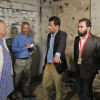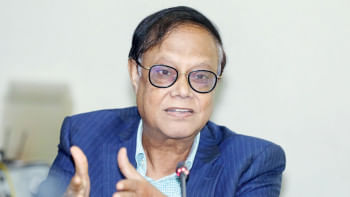‘This is where I was held captive’

When images of Chief Adviser Muhammad Yunus inspecting three secret detention centres emerged in the media yesterday, it did not take long for survivors to recognise the places where they had been held captive.
They had not seen their places of detention since their release (at different times), as these secret centres were off-limits.
Even the commission investigating enforced disappearances had been prohibited from photographing the centers, they alleged in a letter to the chief adviser earlier.
Humam Quader Chowdhury, who was forcibly taken away by plainclothes men on August 4, 2016, was released on March 2, 2017.
He was a part of Yunus's entourage who visited detention centres, or "Aynaghars" in three places in the capital – Agargaon, Kachukhet and Uttara.

Humam recognised the place of his captivity on the ground floor of the Joint Interrogation Cell (JIC) in the Directorate General of Forces Intelligence headquarters in Kachukhet.
"I not only found the cell where I was but also the spot on the wall on which I had carved my initials and the date. It was towards the bottom. They had painted over the wall, but missed that spot.
"When I was asked to identify my cell, I said I would not be able to do it with my eyes open because we were always blindfolded. So, I closed my eyes and found my cell by counting the number of steps I had to take to reach it," said Humam.
Iqbal Chowdhury, who was inside the JIC between May 7, 2018, and April 25, 2019, recognised two rooms as having possibly been his cells.
One room with high walls, now painted pink, looked to him like his main cell. "The hundreds of writings on these walls have now been painted over."
Earlier in 2022, Iqbal had given an interview anonymously to The Daily Star. "My room had an iron bed, and I was given four blankets to make a mattress. A light bulb shone at all times, and an exhaust fan whirred at the corner of the door," he had said.

The other room is a small cell with rugged white walls that Iqbal yesterday recognised as the room where he was interrogated. "I was kept inside that room for three weeks at a stretch."
Former Bangladesh ambassador to Vietnam M Maroof Zaman, an enforced disappearance victim who was kept in an Aynaghar for over 15 months, told The Daily Star that after seeing the photos, he could identify the three rooms and toilet where he was detained in DGFI custody.
"In one of the rooms, a CCTV camera was still visible, but they had removed four fans [that were previously there]. They broke the wall beside the toilet and repainted the rooms.
"There were hundreds of names written on the wall, but they were erased. They tried to destroy all the evidence."
Expressing frustrations, Zaman further said, "The student leaders who were kept there for a few days visited the site. We were held there for years, yet we weren't invited."
Mikel Chakma, who had been held captive since April 2019 and released after the fall of Sheikh Hasina on August 5, also recognised his cell.
He posted the photos of two cells and wrote his reaction on Facebook, saying he was kept inside one of the cells with the rugged white walls and iron gates for nearly two years and later moved to an adjacent cell.
"These rooms were monitored 24 hours with a CCTV camera, as seen on the left side of the photo," he captioned one of the photographs he posted.
The other cell he identified was the same high-walled one recognised by Iqbal. Mikel said he was kept there for a year.
"After this cell, there is one more, and then there is a toilet and a cell in which we would get haircuts."
Another survivor, who preferred anonymity, saw the photos and recognised the cells of the Taskforce Intelligence Centre inside the Rab headquarters in Uttara. "The cell I was kept in had a metal slab with spikes on it on the floor. Those spikes have now been removed."
He added that shackles were attached to the walls to hang and torture victims.
However, the broader community of victims, survivors and their families were not included in the visit.
Sanjida Islam Tulee, coordinator of Mayer Daak, a platform representing families of enforced disappearance victims, staged a protest in front of its Shaheenbagh office, saying that victims continue to be deprived of justice.
"It was our demand that all Aynaghars be opened to the victims and their families. But we're still being stonewalled. Those who have perpetrated the crimes, are still being protected."


 For all latest news, follow The Daily Star's Google News channel.
For all latest news, follow The Daily Star's Google News channel. 








Comments